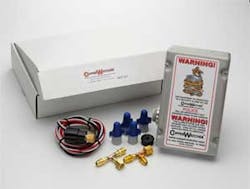Dallas business owner launches copper theft solution
As copper thieves continue to pilfer the air conditioning units of homes and businesses across the country, Bob Frederick and his Dallas, Texas-based company R.W. Frederick & Associates, have developed a new solution that could help put an end to the costly epidemic.
The solution, dubbed CopperWatcher, ties into a home or businesses’ existing alarm system and monitors the supply and applied voltage running to the A/C condenser, as well as refrigerant pressure. If it senses an unusual change in either the voltage or refrigerant pressure, the solution will then trigger an alarm.
Frederick, who has more than 30 years experience in the heating and air conditioning industry and once served as director of engineering for such prestigious Dallas-area hotels as The Adolphus, The Fairmont and The Adams Mark, said he got the idea to develop his solution after a friend of his had five air conditioning units ransacked by copper thieves.
"As I was bidding the job to replace (the units), he asked me if I knew of an alarm system to protect his equipment and unfortunately, the answer I gave him was 'No'," Frederick said. "When I left that job, I realized that someone needs to do something. There weren’t many systems out there and what I found were unreliable."
Shortly thereafter, Frederick began work on CopperWatcher and through a process of trial and error; he was eventually able to develop a near full-proof solution.
Not only is CopperWatcher tamper proof, but since it’s monitored and supervised by the existing alarm system, should there be a power failure, it can still run off of the alarm systems’ battery backup.
"Our philosophy wasn’t to reinvent the wheel…but to enhance the wheel that was already there," Frederick said. "Anything (thieves) try to do to bypass our system, we go into alarm."
Also, because it monitors both supply and applied voltage, CopperWatcher is able to determine the difference between maintenance work or catastrophic failure of the air conditioning unit and an attempted theft, thereby eliminating false alarms. Since hitting the market nearly four months ago, CopperWatcher has been installed in about 50 installations and has yet to record a single false alarm, according to Frederick.
In fact, the solution has already had one success story, saving a Dallas business owner $40,000 in repairs last month after it triggered an alarm when a thief tried to gain access to his rooftop A/C units.
Frederick said that his company is currently marketing and selling CopperWatcher to alarm companies, but he indicated that they are looking for distributors. Currently, CopperWatcher costs $380 per condenser plus installation.
For more information about the solution, visit the CopperWatcher Web site at www.copperwatcher.com or call (817) 684-1216.
